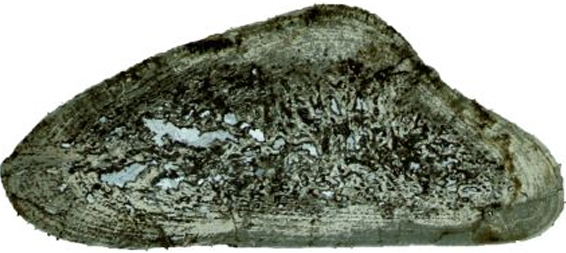Teschner, E. M., Chakravorti, S., Sengupta, D. P., & Konietzko-Meier, D. (2020). Climatic influence on the growth pattern of Panthasaurus maleriensis from the Late Triassic of India deduced from paleohistology. PeerJ, 8, e9868. https://peerj.com/articles/9868/
Published Abstract: “”Metoposaurids are representatives of the extinct amphibian clade Temnospondyli, found on almost every continent exclusively in the Late Triassic deposits. Osteohistologically, it is one of the best-known temnospondyl groups, analyzed with a wide spectrum of methods, such as morphology, morphometry, bone histology or computed modelling. The least known member of Metoposauridae is Panthasaurus maleriensis from the Pranhita-Godavari basin in Central India, being geographically the most southern record of this family. For the first time the bone histology of this taxon was studied with a focus on the intraspecific variability of the histological framework and the relationship between the observed growth pattern and climatic and/or environmental conditions. The studied material includes thin-sections of five long bones, a rib, an ilium and an intercentrum belonging most likely to eight individuals ranging from different ontogenetic stages. All bones have a large medullary region with progressively increasing remodeling, surrounded by a lamellar-zonal tissue type. The primary cortex consists of parallel-fibered matrix showing various degrees of organization, less organized collagen fibers in the zones and higher organized in the annuli. Growth marks occur in the form of alternating zones and annuli in every bone except the ilium and the intercentrum. The vascularity becomes less dense towards the outermost cortex in all sampled limb bones. Towards the outermost cortex the zone thickness is decreasing, in contrast to the avascular annuli, that become thicker or are of the same thickness. The growth pattern of P. maleriensis is uniform and represents changes in ontogenetic development. Multiple resting lines are prominent in the outer annuli of the limb bones and the rib and they presumably indicate climatic and environmental influence on the growth pattern. Therefore, a prolonged phase of slowed-down growth occurred during the unfavorable phase, but a complete cessation of growth indicated by Lines of Arrested Growth (LAGs) is not recorded in the studied samples. Based on the histological framework we conclude that the climate had an impact on the growth pattern. As we do not see any LAGs in the Indian metoposaurid, we assume that the local climate was relatively mild in India during the Late Triassic. A similar prolonged phase of slowed down growth without the occurrence of LAGs was observed in Metoposaurus krasiejowensis from the Late Triassic of Krasiejów (Poland). This is in contrast to Moroccan metoposaurid Dutuitosaurus ouazzoui from the Late Triassic of Argana Basin, where LAGs are regularly deposited throughout ontogeny indicating most likely harsher climatic conditions.“”

Microstructure of the large-sized humerus of Panthasaurus maleriensis (ISA 70) after Teschner et al. 2020
Panthasaurus maleriensis : The Indian Metoposaurid amphibian (After Chakravorti et al. 2019)
Metoposauridae are important Late Triassic temnospondyl family known from nonmarine sediments of Europe, North- America, North Africa and India. Indian taxon Metoposaurus maleriensis (Roychowdhury 1965) became Buettneria maleriensis (Hunt 1993; Sengupta 2002) and thereafter Koskinonodon maleriensis (Mueller 2007). The metoposaurid taxonomy was largely dependent on lacrimal entering into the orbit margin. Sulej(2007) challenged this basis of metoposaurid taxonomy. Hence, the taxonomic status of the Indian metoposaurids became questionable. Metoposaurids being extremely conservative in nature, no single character could be assigned to distinguish them at the species level and there is no alpha taxonomy available. Assigning a taxonomic status of the Indian taxon along with alpha-taxonomy Metoposauridae in lights of morphometry and morphospace has been done. All genera were studied first hand from different museums of the world. Biometric studies were done to analyse the variation between different taxa (Section 2.4; Fig:6). Morphospace of different bones are constructed (Section 2.3). Cladogram using TNT (61 characters over 10 taxa) and comparison of cranial morphology was done. Fourteen parsimonious trees, 50% majority rule consensus, Bremer support value and bootstrap resampling all revealed that Indian taxon occupies a distinct position between European Metoposaurus and North American Koskinonodon. There is also strong bio geographic correlation in the fact that the Indian taxon was widely separated from the main cluster of European and North American taxa. Panthasaurus gen. nov. maleriensis is erected for the Indian taxon of metoposaurids (Appendix III). Biometry and morphospace studies support Indian Metoposauridae to be a separate taxon. The word “Pantha” means “traveller” in Sanskrit. Panthasaurus gen. nov., the travelling beast, alludes to the geographically distant metoposaurid population of India.